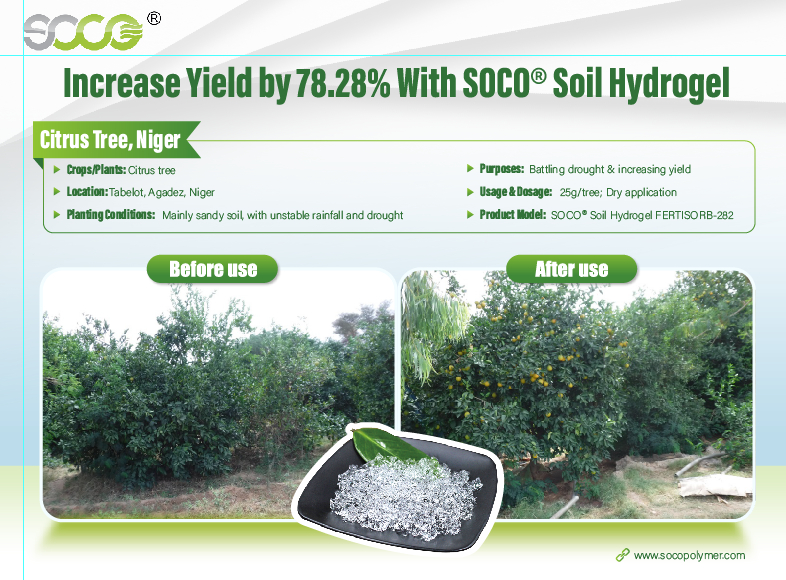As global agriculture rapidly advances, the fertilizer industry plays a crucial role in securing food safety. However, the issues of high input and low efficiency of traditional fertilizers continue to plague farmers and agricultural enterprises. The application of Super Absorbent Polymers (SAP) offers a breakthrough solution for the fertilizer market, enhancing nutrient utilization significantly through its unique water absorption and retention capabilities, positioning it as a vital player in the future agricultural market.

Since 2023, the global fertilizer market has been valued at approximately $200 billion, with an expected annual compound growth rate of 4.5% in the coming years. Global population growth drives the demand for food, particularly in emerging markets such as Africa and Latin America. Asia, especially China and India, are the largest consumers of fertilizers, accounting for 60% of the global market.
However, the fertilizer industry still faces several core challenges:
Low utilization rates: The effective utilization of traditional chemical fertilizers is usually only 30%-50%, leading to significant nutrient loss to the environment, causing water pollution and soil degradation.
Resource scarcity and price volatility: Fluctuations in the prices of raw materials such as nitrogen, phosphorus, and potassium add uncertainty to agricultural production.
Increased environmental pressures: With growing global environmental awareness, the ecological issues caused by the overuse of chemical fertilizers have led governments to implement stricter fertilizer usage policies.
In response, various countries have introduced new policies and regulations:
European Union: Enforcing strict chemical fertilizer usage regulations, promoting the growth of organic and environmentally friendly fertilizers.
USA: The EPA is studying new fertilizer standards to reduce agricultural pollution.
India: Government subsidies for nitrogen and phosphorus fertilizers make these more competitive in the market.
China: Advancing the "Zero Growth Action of Chemical Fertilizers," encouraging the use of organic fertilizers and reduced fertilization techniques.
On the other hand, the trials and applications of SAP in the fertilizer sector are becoming increasingly important.
SAP, known for its outstanding water absorption and retention capabilities, is gradually being introduced into the fertilizer market. It absorbs and locks in soil moisture, slowly releasing it near the root systems, not only improving the soil's moisture retention but also delaying nutrient loss.
Application methods and characteristics:
Blended application: SAP is typically mixed with fertilizers, using its powerful water-absorbing capacity to absorb moisture when plentiful and release it slowly during droughts, maintaining long-term fertilizer activity and improving nutrient utilization. SAP can also be blended during the fertilizer granulation process, producing new types of fertilizers with high water absorption, retention, and slow-release capabilities.
Slow-release action: Unlike chemically controlled slow-release fertilizers, SAP delays nutrient loss through a physical slow-release process by absorbing and releasing water.
Soil improvement: In deserts or barren soils, SAP mixed with fertilizers can effectively improve soil structure, enhancing its moisture and nutrient retention capacity.
The most significant advantage of SAP fertilizers is their performance in drought-prone areas and high-water-demand crops, significantly reducing irrigation needs and fertilizer loss, especially suitable for water-scarce regions practicing water-saving agriculture.
In terms of slow-release functionality, SAP blended fertilizers and traditional slow-release fertilizers have their respective advantages and disadvantages:
SAP blended fertilizers:
Advantages: Relies on water-absorbing properties to automatically regulate nutrient release based on environmental moisture conditions. Suitable for dry, desertified, and water-stressed areas. Can reduce irrigation frequency, saving water resources, especially beneficial in water-scarce regions.
Disadvantages: SAP's water absorption and nutrient release depend on environmental moisture; if soil moisture is too low, slow-release effects may be limited. In specific environments, more research is needed on the degradability of SAP materials to ensure they do not cause long-term environmental impacts.
Traditional slow-release fertilizers:
Advantages: Nutrient release rate can be controlled through chemical coating or modification techniques, independent of moisture, suitable for large-scale intensive agriculture. Release cycles are precisely designed to cater to crop nutrient demands.
Disadvantages: Higher production costs, and some slow-release fertilizer coatings are non-degradable, potentially causing environmental pollution. In extreme drought or water scarcity, the nutrient release efficiency of slow-release fertilizers may decrease.
Superabsorbent polymer fertilizers demonstrate high potential in multiple agricultural scenarios, especially in water-scarce, drought-prone areas, and in cultivating high-value crops. Qingdao SOCO’s soil hydrogel SAP in have seen many successful cases in fertilizer applications, confirming the promising prospects of SAP application.
Typical application scenarios:
Agriculture in dry regions: In dry areas such as the Middle East and Africa, SAP fertilizers reduce water loss and enhance crop drought tolerance. For instance, in some arid regions of South Africa, the application of SAP fertilizers has significantly increased the yields of maize and wheat.

Horticultural crops: In California, USA, fruit trees using SAP mixed fertilizers have shown greater drought resistance and higher fruit yields.

Soil improvement and ecological restoration: In Australia, SAP fertilizers are used to restore degraded grasslands and forests by enhancing soil water retention, significantly advancing ecological restoration efforts.

Future Trends and Opportunities
With continuous advancements in SAP technology, improving its water retention, biodegradability, and salt tolerance, its application scenarios in the fertilizer field are expanding. Globally, especially in drought-prone areas and countries with agricultural water stress, the market demand for SAP fertilizers continues to rise. China's "14th Five-Year Plan" explicitly proposes advancing water-saving agriculture, aligning perfectly with the application of SAP.
The application of SAP brings innovative solutions to the fertilizer industry, improving soil water retention, extending nutrient efficacy, and enhancing fertilizer utilization. SAP fertilizers not only meet the modern agricultural demands for resource conservation but also provide practical agricultural production solutions for drought-prone and barren regions. As technology progresses and market education becomes widespread, the future development prospects of SAP fertilizers are broad, poised to occupy a significant position in the global agricultural market.